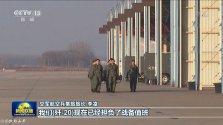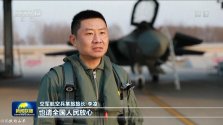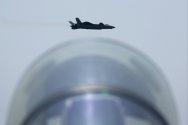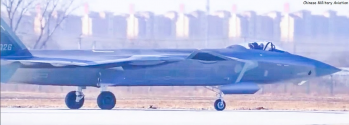I know. And they’ve released the video of J-20 banking with full afterburner at night several years ago.
You are using an out of date browser. It may not display this or other websites correctly.
You should upgrade or use an alternative browser.
You should upgrade or use an alternative browser.
J-20 5th Generation Fighter VII
- Thread starter siegecrossbow
- Start date
- Status
- Not open for further replies.
Since you posted it ... since a few days I have issues with Sina. Usually I see the images posted as small tiles and whenever I click on them, they enlarge ... now I think since Wednesday last week nothing happens and a right-click to download results in only a small version of a certain image.
Can anyone help?
Since you posted it ... since a few days I have issues with Sina. Usually I see the images posted as small tiles and whenever I click on them, they enlarge ... now I think since Wednesday last week nothing happens and a right-click to download results in only a small version of a certain image.
Can anyone help?
I have uploaded this video to my YouTube channel.
Close calls for China’s J-20 before stealth fighter’s deployment, Avic says
- Manufacturer says a serious incident was narrowly averted in 2012 and warnings sounded in 2016
- The fifth-generation jet made its maiden flight more than a decade ago
The J-20 stealth fighter is central to China’s plans to modernise its military. Photo: AP
China’s most advanced stealth fighter the J-20 narrowly avoided a “serious accident” in a test flight nine years ago during the early days of the aircraft’s development, according to its manufacturer.
Aviation Industry Corporation of China (Avic) said the incident occurred on December 18, 2012, as one of the aircraft was taxiing on a runway, taxiing at high speed.
The cockpit panel readings were green but ground data sensors sounded a warning and ground control ordered the test to be aborted immediately, just three minutes into the procedure.
“According to retro analysis, had the order been 2 to 3 minutes later, a major accident could have occurred,” Avic said on its social media account on Wednesday to mark the 11th anniversary of the plane’s maiden flight.
The Chengdu J-20 is the third fifth-generation stealth fighter in service in the world and a key element of China’s ambitions to modernise its military and draw level with other major powers.
But it was not easy leapfrogging some of the most advanced technologies. Another J-20 plane fault was reported during a test flight on May 17, 2016, Avic said.
During that incident, monitoring software sounded a warning, and ground control and engineers guided the pilot to resolve the problem and return safely to ground.
Avic did not specify the nature of these events, saying only that during the test flights the team also discovered “many other severe load conditions that were not expected in the design stages”, such as overloading of hinged sections of the wings and uncommanded uplift of the aircraft.
The J-20 made an unannounced maiden flight on January 11, 2011, the same day as then US secretary of defence Robert Gates met then Chinese president Hu Jintao in Beijing. Hu assured Gates the timing was little more than coincidence.
Pilot Li Gang, who carried out this flight, was later awarded the Gold Medal of Honour for Meritorious Pilots, one of the highest honours of the PLA Air Force.
The aircraft went through thousands of tests and subsequent modifications, including a test in 2016 on “the world’s highest airfield for fixed-wing aircraft”, a possible reference to Daocheng Yading Airport, which is 4,411m (14,472 feet) above sea level.
The aircraft finally entered service in 2017.
Some of the changes were to ensure the aircraft’s performance at high altitudes, with a couple of J-20s forward deployed at the Karakorum and Himalayan borders during a military stand-off with India in 2020, confronting India’s newly bought Dassault Rafales from France.
The 2011 launch of the J-20 came just six years after the introduction of the fourth-generation Chengdu J-10 fighter. Many observers were shocked at China’s ability to present so quickly a stealth aircraft with supersonic cruise capabilities, super manoeuvrability and super avionics.
What's particularly revealing from the piece:
Not sure how common is it that high speed taxiing would cause such stress on the wings, perhaps due to the wings being flexible in nature, coupled with vibrations while on ground esp. at high speeds could've caused the wings to 'flap' more than they should have, which could explain the overloading issue... and if the fuel tanks in those wings were full, then it could've exacerbated the issue even further, I'd reckon. But that's just my guess.Avic did not specify the nature of these events, saying only that during the test flights the team also discovered “many other severe load conditions that were not expected in the design stages”, such as overloading of hinged sections of the wings and uncommanded uplift of the aircraft.
It's an interesting anecdote from AVIC nonetheless.
What's particularly revealing from the piece:
Not sure how common is it that high speed taxiing would cause such stress on the wings, perhaps due to the wings being flexible in nature, coupled with vibrations while on ground esp. at high speeds could've caused the wings to 'flap' more than they should have, which could explain the overloading issue... and if the fuel tanks in those wings were full, then it could've exacerbated the issue even further, I'd reckon. But that's just my guess.
It's an interesting anecdote from AVIC nonetheless.
There is no smooth sailing with developing new aircraft, especially when so much radically new technologies are being used for the first time.
Slowly images of J-20As assigned to the 1st Air Brigade at Anshan are being released ... here is no. 61026
(Image via Huitong's CMA-Blog)
View attachment 81365
Seems like he made a mistake and labelled 61120 and 81120.
View attachment 81270
The rumours of J-20 testing with WS-15 in early 2021 was accompanied by rumors (repeated recently) that J-20 wasn't testing a WS-15 but a TVC WS-10. The right most image show petals very similar in appearance to the J-10B's TVC engine petals.
This could be the reason why there are rumours that the engine that was tested on the J-20 isn't a WS-15 but a TVC WS-10 similar to the J-10 experimental TVC.
View attachment 81271
They do look identical.
We should remember though that Gongke said the WS-15's nozzles (petals) look very similar to that of the WS-10 TVC. This would mean there is every possibility that the engine flying on the J-20 is a WS-15 which just happens to have the same nozzle design as the WS-10 TVC. If this is the case, it could indicate that the WS-15 implemented is going to be with TVC right from the get go.
So basically the reason there are rumours the J-20 is testing a TVC WS-10 is because the WS-15 has very similar nozzle appearance to TVC WS-10.
I suspect a more complex TVC nozzle would not be shorter than a standard nozzle, and it would have no effect on the length of the afterburner before it. So WS-10 with TVC won’t be noticeably shorter than a standard WS-10. In any case, if the WS-10 with TVC nozzle was shorter than one with a normal nozzle, that would have been obvious on the J-10 testbed for the TVC nozzle.
So my hunch is the fact that one engine ends further forward then the other implies the shorter engine has a shorter core or shorter afterburner. The Chinese have no known trouble with afterburner technology and if the afterburner for the WS-10 could have been made shorter, the Chinese would have made it shorter to start with. This suggest the shorter engine has a shorter core. A substantially shorter engine with the same or greater output suggest fewer fan, compressor or turbine stages and better blade technology. Such a drastic configuration difference strongly suggest it is a new engine, ie WS-15.
So If the photo showing a shorter engine on the J20 isn’t a piece of fanboy photoshop work, then my money I’d it shows a genuine WS-15 engine on that J20.
Last edited:
- Status
- Not open for further replies.




